 Logo handmade by Bannister
Column by Scott Green
Logo handmade by Bannister
Column by Scott Green
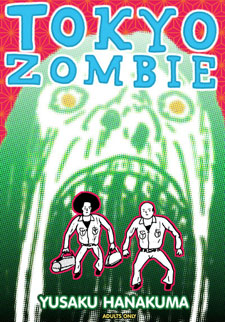
Tokyo Zombie By Yusuku Hanakuma Published by Last Gasp
Scream your favorite catch phrase, because it's time for Royce Gracie of the Dead. Like a lot of genre people, AICN gave some love to Noboru Iguchi's Machine Girl. Given the difference in media, Tokyo Zombie is unlikely to receive as much favor. However, if Yusaku Hanakuma's jiu-jitsu versus the undead manga had a nice sizzle reel like Machine Girl's, I'd like to think that it would generate at least as much talk. Imagine a scene of a man with an afro in a gi arm barring the limb off a zombie pro-wrestler, and imagine what that would do for its list of Key Words if the Tokyo Zombie manga had its own IMDB entry. Assuming for a moment that the list of "Plot Keywords" has some value in assessing a exploitation work's heft, then, consider that Tokyo Zombie's list of Key Words would likely match, if not exceed Machine Girl's. (For example, I thought that it would be missing "Eye Injury", but then I rethought the manga and realized that it certainly is not.) In Yusaku Hanakuma's own words: "I made sure to give fans what they wanted (or at least I tried). I crammed in zombies, trucks, pro wrestling, martial arts, factories, Mt. Fuji, pigs, intense battles, wealthy people, slaves, porno, gym teachers, a little dog, Calipis, tonkatsu, a prince, a professor and so on, to try and create a comic that was a sort of fin de siecle celebration of manliness." Quoting pop culture might be a lazy tool for commenting on pop culture, but reading Tokyo Zombie, then reading Hanakuma's intensions... in the words of Bender... "I'm gonna go build my own theme park, with blackjack and hookers." If you are unfamiliar with jujutsu, think of a martial art that focuses on grappling with an opponent with the aim to ultimately end the fight with a joint lock or choke. In America, the Brazilian Jiu-Jitsu branch of the form came to prominence with the first Ultimate Fighting Championship (UFC) event. Before the UFC became the fight promotion that it currently is, with current ownership/ management running event sanctioned by state athletic commissions under a unified set of rules, Art Davie, John Milius (yes, THE John Milius), Robert Meyrowitz and Rorion Gracie conceived a tournament that would pit fighters from different backgrounds in an eight sided cage. A boxer, a sumo, kick boxers, a savateur, a shoot fighter, a karateka, and Rorion Gracie's brother, Brazilian Jiu-Jitsu black belt Royce Gracie, squared off. At the time, the crowd expectation was that a fighter from a striking martial art would win such a clash of styles. As such, Royce Gracie's grappling based domination of his opponents, emphasized by the fact that in this no-weight class competition, he was noticeably the smaller fighter, turned UFC 1 into a showcase for Gracie Jiu-Jitsu. There are certain people who are presumed to be well suited for a zombie apocalypse... survivalists, strategic masterminds, various people whose occupations don't involve staring at a computer all day. Given their intensity and zealous faith in their martial art, various hardcore jujitsu practitioners might have a useful mindset for a zombie invasion. for example: “Back in the day, a Ninja didn’t have his girlfriend sitting in the tree waiting to kill shit.” - Cesar Gracie black belt Nick Diaz on division rival/champion K.J. Noons bringing his girlfriend and family into the ring to celebrate a victory. "If a guy comes up to you on the street, do you ask him what he weighs? What would a caveman do?" -First American-born winner of the World Jiu-Jitsu Championship in the black belt division, current UFC Lightweight Champion BJ Penn on moving from one weight class to another, starting with 155lb and up as high as 205lb Mitsuo (aka Hage or Baldie) and Fujio (aka Afro) are far from chiseled mixed martial arts warriors, but the sempei - kohei / senior - junior pair would seem to have a leg-up on undead-prep. These blue collar workers identify themselves as jujutsu practitioners to the extent that Tokyo Zombie first finds them with a makeshift mat set up, spending their lunch break on the ground, perfecting jujitsu guards. During this session, the factory manager shows up. He steps on the mat with his shoes. He gives them a bit of "You two sure are close, huh?" And, after he's impugned the pair, Fujio gets behind him and clubs him dead with a metal pipe. Heroic murder of a disrespectful boss is the first, and maybe most minor of Tokyo Zombie's catalogue of ridiculous violence. Though Mitsuo reacts to the killing with incredibly, the manga itself adopts Fujio's "what'd you expect?" Attitude. The beauty of Tokyo Zombie is that as gratuitous and obscene as it is, with all of its decapitations and its castrations, it's honest and in its own way, logical. Stray dogs bite. Pigs eat severed arms. Something that is broken before a zombie attack is going to be broken afterwards. "What'd you expect?" Mitsuo and Fujio bring the manager's body to the mountain of trash known as Dark Fuji: "The mountain was called Dark Fuji, but to the locals it was better known as a Mecca for dumping garbage... If you dug your own hole and kept a low profile, nobody asked questions. Over the years, Dark Fuji became not only the place to dump unwanted trash, but also for burying corpses. And sometimes the ones that got buried weren't even dead yet. " So, with the buried TV sets and stacks of porno, Mitsuo and Fujio's new contribution to Dark Fuji is accompanied by the work of a junior high gym teacher hiding the body of a student that he punished a bit too strictly, and a husband with his domineering wife and his domineering, now dead mother. But, to the misfortune of the gym teacher and the couple, they had picked the day where all of the bodies, broken appliances, illicit material and industrial waste piled on and in Dark Fuji hit a critical threshold. Tokyo Zombie transitions between a trashy version of the apocalyptic inferno that Hayao Miyazaki recounted in the opening mosaics of Nauseas of the Valley of the Wind, and a TV talking head with a bad mustache and ponytail, explaining how the spirits of the buried alive, the discarded bodies and the industrial sludge combined to unleash a plague of zombies onto the urban Japan. By the general standards of a modern society, the zombie immergence from Dark Fuji changes everything. Except, the new world is far from a state of anarchy. From the Fujio "what'd you expect" perspective, it's rather unchanged. The rich are still rich. The cruel are still cruel. The bottom of the totem pole before remained the bottom of the totem pole after. If something has change, it's that qualitatively, the sadism of the system is wrenched up to a point where a real revolution is possible... Verisimilitude is not what you would expect when seeing huge, round pro-wrestlers leg dropping zombies affixed with bunny masks. However, beyond the fever pitch of men trying to avoid zombie bites while dispatching the undead with their bare hands, there's truth to the dementia. Like the best zombie stories, like World War Z, like Romero at his best or Shaun of the Dead, the characters insistently act how they, as people, would act rather than how a horror script might insist that they act. This is reflected in the manga's action. During a mixed martial arts competition, if a fight transitions from people standing, trading strikes with the intention of scoring a knock out, to ground-based grappling, generally, someone at the event will proclaim their enthusiasm for technical grappling by yelling something to the effect "get a room!" A key component of Tokyo Zombie's climax features Fujio dueling the uber zombie who single handedly wiped out 100 police officers "like a berserk Gundam." The fight turns into a jujitsu showdown, with the crowd generally screaming "this is bullshit!", while other martial artists look on in amazement. The irony of that crowd's criticism is that unlike the battles they may have previously been party to, Fujio versus the uber zombie was anything but "bullshit." What's hilarious and endearing about Tokyo Zombie is that, even if the next dark corner might be hiding a stray zombie looking to rip out their intestines, the people of Tokyo Zombie are what they are. Yusaku Hanakuma expresses this accuracy in a style of manga illustration referred to as heta-uma or "good-bad." From the discussion of Teruhiko Yumura aka "King Terry" in Frederik L. Schodt's Dreamland Japan: Writings on Modern Manga. "I wanted to draw the picture I wanted in the space provided, rather than tell a story. I started drawing whatever I wanted in each panel, and because I can't draw the same face twice, the character faces all changed." The result was manga with a weird mix of primitivism, energy and dada-ist storylines - a comic where the art, the text and the entire concept fused together in a good-bad style... At first glance Terry's cartoons appear to be bad art, but on close inspection, they are also good. Hence, they are heta-uma or bad-good. Terry believes that everyone starts as a "bad" artist and tries to become good. But simply becoming "good" is not enough. Artists who try too hard to become "good" emphasize technique over soul, and the life goes out of their drawings; their spirit fails to live up to their technique. In theory, found footage horror is supposed to appear true to life, but even then, there is the affectation of characters behaving for a camera and a director trying to make the film look naturally occurring. In Tokyo Zombie, Hanakuma's heta-uma style of work means a "damn the expectation, damn the craft" approach to telling the story of a guy in a gi terminating zombies. In design, the adage is "simple is hard." In comic illustration, presumably, rough is also hard. A glance at Tokyo Zombie shows pages that look ripped out at rapid speed. If you are not an artist, it is hard to reverse engineer a page of manga.. envisioning the rules and zip tones, layering the construction of the image. Looking from the illegible handwriting of most people to the intricacies of lines in a character's hair from even a nondescript manga, the gap seems almost insurmountable. In contrast, examining a page of Tokyo Zombie, you can almost see the pen flailing out each panel: four fingers and a thumb wrapped in a fist, a sleeve and a jutting explosion of blood. In a punk sense, you can picture almost anyone with the right intension scratching out the image. At the same time, images are anything but haphazard. Jujitsu can probably be added to the list of types of motion that are difficult to capture in comics. Yuji Shiozaki (Ikkitousen) or Oh!great (Tenjho Tenge) can draw a sexy panel of a buxom teenage girl throwing someone in a joint popping hold, but neither really delves into the complex exchange of motions, where one person is sinking weight onto a hip or trying to wedge a knee into position, struggling to set up a hold that might be eight moves down in the gambit. Hanakuma is a practitioner of Ichibanbosi Grappling, so, even if a page of Tokyo Zombie looks like it was urgently rushed into existence, there is also evident care taken to capturing the precise steps in the motion of jujitsu. That Hanakuma actually projects those exchanges onto the comic page demonstrates a technical skill and and mindset for the medium that might not be obvious from the raw character sketches. Like Fujio versus the uber zombie, Tokyo Zombie itself does not look like a performance. It's not done up for the observer's benefit. Guy one versus guy two, trying to win. If the crowd does not care about the strategy to break a guard, that's their problem. If they think a sketched out panel of a gathering of unwashed, unshaven, rough wilderness dwellers is ugly as sin, well, that's their problem. Is that approach, with its fugly style of illustration, at odds with the "I made sure to give fans what they wanted (or at least I tried)" mission statement? If you insist on painstakingly rendered illustration, maybe the style does not mesh with the fan-service sentiment. But, if you want to see guys fucking up zombies, and want to see a work where it is evident that the creator is excitedly scratching out a plan for matching his 'jits against the undead, then Tokyo Zombie is more than you ever thought was possible. So, yell out "Jutitsu!" or Knightrider!" fork out the princely sum of $9.95, and invest in some manga that you can leave on your coffee table for vicariously reflecting on true, badass zombie action.
Preview
click on images for readable versions
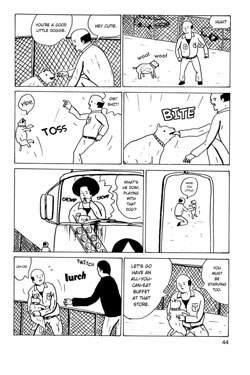 | 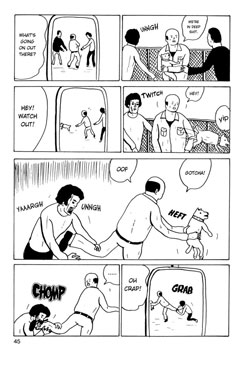 |
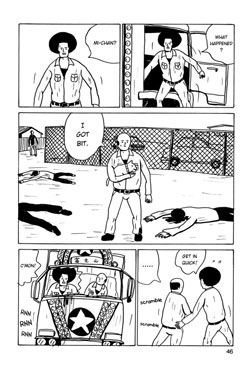 |  |
 |
Other Points of Interest
Tokyo Zombie Art Show Tokyo Zombie was adapted into a live action film, written and directed by Sakichi Satô (writer of the Ichi the Killer screenplay, Kill Bill's "Charlie Brown"), starring Tadanobu Asano (Ichi the Killer's Kakihara) as Fujio and Sho Aikawa (the Dead or Alive films, Gozu) as Mitsuo . Note the Kazuo Umezu cameo. Tokyo Zombie was localized by the people at must-read blog Same Hat! Same Hat! "Weekly manga commentary, featuring horror, gag & erotic-grotesque nonsense: Please check out the archives for older posts!"
Speaking of manga...
This past weekend, San Diego Comic con was the site for the 2008 Eisner Awards. Taiyo Matsumoto's Tekkon Kinkreet was recognized for Best U.S. Edition of International Material—Japan. Other manga nominees included : The Ice Wanderer and Other Stories by Jiro Taniguchi MW by Osamu Tezuka (reviewed here) Naoki Urasawa’s Monster, by Naoki Urasawa New Engineering by Yuichi Yokoyama Town of Evening Calm, Country of Cherry Blossoms by Fumiyo Kouno (Reviewed here) Naoki Urasawa's Monster for Best Continuing Series: (preview volumes 2 and 3) Kiyohiko Azuma's Yotsuba was nomonated for Best Publication for Kids (volume 1 volumes 2 and 3 volume 4 talk of series availability) Apollo’s Song by Osamu Tezuka was nominated for Best Archival Collection/Project—Comic Books Fumi Yoshinaga (Flower of Life) was animated for Best Writer/Artist Takeshi Obata (Death Note) was nominated for Best Penciller/Inker Jason Thompson's Manga: The Complete Guide (reviewed here) and Robin Brenner's Understanding Manga and Anime were nominated for Best Comics-Related Book
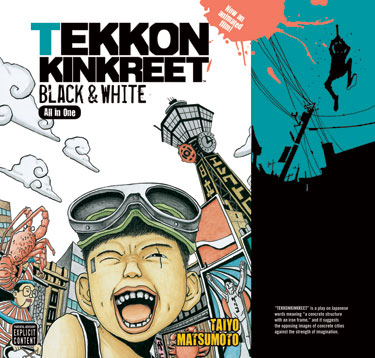 © 1994 Taiyo MATSUMOTO/Shogakukan Inc.
© 1994 Taiyo MATSUMOTO/Shogakukan Inc.
Manga Spotlight: Tekkon Kinkreet: Black&White All in One edition by Taiyo Matsumoto Viz Media
The spirit of Tekkon Kinkreet is a bit like the comic equivalent of a given pre-point of over commercialization stage of a youth music movement. It's Batman by way of an urban variant on Steinbeck by way of Clockwork Orange. A pair of roof top inner-city avengers patrol the metropolitan landscape, swooping down from their lofty posts to bloody the guys who try to screw them and to issue beat downs on those who slight them, or the miscreants they protect. This story of a pair of opposites forcing their way in the world is honest and spirited and it's rush-filled, explicit assault on conformity has the kind of angry youth spirit that's frequently only suggested. Treasure Town has a decidedly unplanned urban layout and unique, schlock pan-culture amalgam aesthetic: a kind of post-dated Hong Kong meets old Vegas, minus the glass, neon and glitz, where signboards compete for attention the way a tangle of vines might compete for sunlight, where urban primitive gangs in Mad Max dress and conservative "good citizens" in numbered black body suits roam the streets. At the same time, with transportation and public works, merchants and trash piling up on the street corners, it functions like any other city in human history. Business, organized crime, and police contend for control, of Treasure Town but at the top of the food chain are the Cats: yin-yang partners Black and White. Black is the spirit of the city: scheming, studied, quick thinking, cynically analytical, both brutally efficient and viciously temperamental, and his partner/charge White is an innocent unaffected by the quagmire of a rotting city, a mentally deficient boy with a natural, savage tendency for violence. While White can't dress himself, he can kick and fight like his partner, and unlike Black, he can see beyond immediate limitations to dream of apple trees and bright possibilities. Together, any individual or institution who tries to tame them is bound to be beaten into unconsciousness with a studded rod. Tekkon Kinreet's initial call to action is the return of "The Rat", a brutally capable yakuza captain credited with the ability to darken the character of the city. However, this might be an over-sold or under-considered assessment. Though The Rat and his fierce protege Kimura are capable of snuffing out the city's weaker gangs, the yakuza still fit into the tooth and nail ecology of Treasure Town. Even if they ride rough shot over most of their adversaries, they are still subject to the local checks and balances. The graver threat to Treasure Town comes with the building of the "Kiddie Kastle" arcade. All of a sudden, with the invasion of a globalized, Disneyfied force, what had been a personal conflict becomes impersonal. It's a push for the extinction of the sleazy in favor of the heartless. In place of the yakuza's disquieting tactics of applying leverage, in that new corporate, industrial warfare mindset, assets are set to exterminate threats like the Cats. Like a song, you don't have to follow Tekkon Kinkreet word for word to pick up the spirit of it. There is an unadorned direct voice where characters will explicitly lay out the situation and the meaning in the dialog. And, there are dreams and allusions that call to be puzzled over or interpreted. By the same token, the manga is given to poetic imagery. Throughout, the idea and the literal are interchangeable. This can take the shape of goofy extensions of the work's freeform style such as a hippo-lady sitting in a trolly car or a peepshow stripper being replaced by a fish-man playing the blues on a shamisen. Or, these mirages can be more substantial. As one manifested totem says "I look ugly to you huh? But I tell the truth. I AM your truth." Early on, the manga introduces its Rosencrantz and Guildenstern detectives. The veteran Mr Fujimura placed third in the Japanese judo championship. Mr. Sawada, the young ear-bud wearing ace graduated from the prestigious Tokyo University and destroyed the officers exam. It turns out Sawada is a Dirty Harry-wannabe who became a cop to fire a gun. And, it turns out that Sawada is literally and figuratively impotent. To the disappointment of Sawada's romanticized notions, the manga does not enter into the business of fight promotion. As violent as Tekkon Kinkreet is, it is staged such that matters are not satisfactorily resolved through violence. Yet, the manga does feature ears being cut off, chunks of ears being bit off, just about anything you could do to foe using a studded metal rod without being outright sadistic, and even a bit of a muay thai match. This is a manga that ran in Weekly Big Comic Spirits, home of a diverse range of works for the Spike TV demographic, including Rumiko Takahashi's post high-school relationship epic Maison Ikkoku, Junji Ito's gruesome, literally twisted horror Umzumaki and Kazuo Koike/Ryoichi Ikegami's warped pulp actions Crying Freeman and Wounded Man. It's not as if matters are not settled through force in the world of Tekkon Kinkreet. And, it's not as if the manga does not acknowledge that some segments of its readership, or maybe even the majority, are looking for some excitement in the work. The first third features plenty of a Tekkon Kinkreet remix of yakuza action: street beatings, and tense, close quarter set pieces, only in this case, with jumping off a roof top and diving in or out of a window. The second third has the pair set against more off-beat foes: a pair of would be rivals and a juggernaut assassin. In here, the manga tears through the city. An engagement might start on a roof, before the combatants leap onto the moving traffic; hanging on a speeding bus before dropping down again to skid on the street. With a Batman or Spider-Man, the still image of figure standing on a ledge might look impressive, but thinking how they got there could suggest a clumsy process. Hefting yourself onto a gargoyle or actually climbing a couple of stories seem like inelegant tasks. Tekkon Kinkreet does indulge in this sort of posing, but it works because the manga's heroes are kids, and seeing them skulk and stalk their prey, shimmying up a utility pole seems natural. And, it works because, the characters live up to their "Cat" moniker. The manga is full of point of impact or behind the should panels during the movement. When one of the cats vaults up or springs down, the manga travels with the force of the action. Manga artists such as Jiroh Taniguchi (Benkei in New York, Hotel Harbor View) or Akira's Katsuhiro Otomo have demonstrated a style of manga that is influenced by European comics. In these cases, the style has been marked by clean, precise lines, lending an intellectualized impression to the depiction of events. Taiyo Matsumoto has credited creators like Moebius as inspirations for his work, but unlike Otomo's or Taniguchi's approach, there is an emphasized human ugliness to Matsumoto's style. Whether it is a function of the face's features or the angle by which it is captured, there is a perpetual and deliberate asymmetry. At the same time, Matsumoto calls attention to the flaws: chipped, badly spaced teeth; tacky hair styles; wrinkles or scars and the like. There is a more forceful notion of breathing humans in these characters than in more idealized manga. Despite the clear distinctive features of each individual, Matsumoto's approach still has the openness that allows readers to empathize and project onto manga characters. The design is not so specific that it blocks out the space needed to apply an impression to the characters. While Matsumoto has a strikingly particular style, the abstract note gives him the flexibility to quickly shift focus, and he uses this to blink into different metaphors. As Black declares, "this is MY town", he goes into the binary black and white of Frank Miller's Sin City work. When the concept of a minotaur spirit is brought up, the monster is captured like how Mike Mignola might depict it. In the moment where a dangerous foes blood is finally drawn, the strike is captured with the calligraphy brush-inked strokes of Hiroshi Hirata's Satsuma Gishiden or Lone Wolf and Cub's hellish fever dream. Tekkon Kinkreet has had something of a noteworthy publication history in North America. Few releases have taken its particular shape. It started off under the title "Black & White" in Viz's lamented Pulp anthology, where it ran alongside the likes Uzumaki, Buronson and Ryoichi Ikegami's Strain, Hideo Yamamoto's (Ichi The Killer) Voyeurs, Toyokazu Matsunaga's Bakune Young, Naoki Yamamoto's Dance Till Tomorrow. Akimi Yoshida's Banana Fish and more. It was then spun off into traditional American format monthlies (about 40 pages each ) for its conclusion. Circa 2000, before the $10 manga collection format really exploded, Viz repackaged Black & White in three 7.9" x 5.5" collections at $15.95 each. All of these prints were in the English-native left-to-right format. And like the previous versions, the newest print is mirrored for left to right. After seeing a majority of manga right-to-left in recent years, that a prominently featured character is advancing while brandishing a weapon in his left hand is noticeable. Especially with his character stretching out his arm and point, he draws attention to the issue that , in this altered format, everyone is in fact, left handed. Now, Sony is about to put out the North American DVD of the animated adaptation of Tekkon Kinkreet , produced by Studio 4°C (Animatrix, Mind Game), directed by Michael Arias (Animatrix, software for Princess Mononoke, effects work on the Abyss) and written by Anthony Weintraub. Maybe the manga would have been re-printed without the movie tie-in, but that link does seem to be the justification for the manga's publication in its impressive new format. The bookshelf worthy manga receives a bookshelf worthy edition. $29.95 is more than most North American manga collections go for, but with 620 pages in a 7" x 10 1/8" volume, the book has a physical heft that most manga releases lack. While the mirroring is noticeable, slightly irritation and in a few instances distracting, the inclusion of the original colored opening pages and a few bonus features (a fold out, Weintraub interviewing Arias) do highlight one of the more tactilely satisfying collections of manga on the North American market. There's plenty of diverting manga that capture you attention for awhile. There are a few substantial manga, that are worthy of longer consideration. Taiyo Matsumoto manga, including Tekkon Kinkreet, and his other English translated works, Blue Spring and No. 5, are rare experiences. They might not be improvised, but it feels like Matsumoto is riffing off the spirit of an idea. Tekkon Kinkreet is imaginative. I's energetic. If you want a manga that DOES something, Tekkon Kinkreet is the manga to read.
